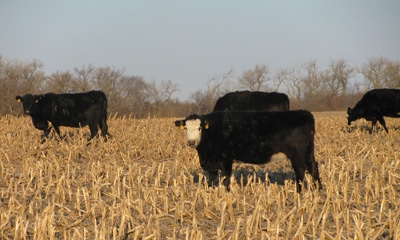
Several long-term University of Nebraska studies on cornstalk grazing finds there is little to no impact on subsequent crop yields after grazing stalks in the fall or spring. Some UNL studies suggest that soybean yields following grazing may increase yield by 2 to 3 bushels per acre. There is, however, a perception by some landowners that grazing compacts the soil and removes nutrients and organic matter from the field.

When recommendations are followed during grazing, the practice has little impact on compaction, or nutrients and organic matter, according to Nebraska Extension beef systems specialist Mary Drewnoski.
"Producers comparing grazed and non-grazed fields in the spring may perceive that heavily grazed fields are compacted," says Nebraska Extension beef systems specialist Mary Drewnoski. "This is because the removal of residue may speed up drying of the soil." According to Drewnoski, when you run your planter through drier soils, more downward pressure might be needed than on wetter soils. "Moist soils have less resistance than drier soils typically," she adds.
But long-term UNL studies have shown no actual impact from grazing cornstalks. "A UNL long-term experiment in a soil with 2% organic matter showed that there were no positive or negative impacts on both corn and soybean yields in both tilled and no-till soils following grazing," she explains. "After 18 years of grazing in the fall and the spring on no-till fields, bulk density, which is related to porosity of the soil, was not affected by grazing in either season, and penetration resistance was not affected to the point where root growth would have been impacted."
She acknowledges that there may be some soil surface roughness around water tanks, feed bunks or in areas where high concentrations of animals may congregate during the fall or spring, but some producers simply disk these areas lightly to smooth them out.
Producers are also concerned about losing nutrients during cornstalk grazing. But Drewnoski says that there is no consequential loss of nutrients or organic matter. "When cattle are grazing at the recommended rates, they are only consuming about 15% of the residue in the field," she says. "About 50% of the carbon is then excreted back as manure, and this carbon is in a form that can more readily contribute to soil stable carbon than residue on the soil surface."
She says 80% to 90% of the nitrogen, phosphorus and potassium that cattle consume will also be excreted, so the net removal of carbon and nutrients due to grazing is minimal. "In fact, when cattle are being supplemented on the field, nutrients are actually being imported," Drewnoski says. "However, with grazing, the redistribution of nutrients may not be even, as areas they tend to congregate to, such as near water or around windbreaks, will receive a greater proportion of these excretions than other parts of the field."
She adds that the long-term grazing of corn residue increased microbial populations of the soil, so the practice may also increase nutrient cycling, which may explain the improvement in yields that are sometimes observed with grazing residue.
You can learn more about cornstalk grazing by visiting UNL’s Beef Forage Crops Systems page.
About the Author(s)
You May Also Like






